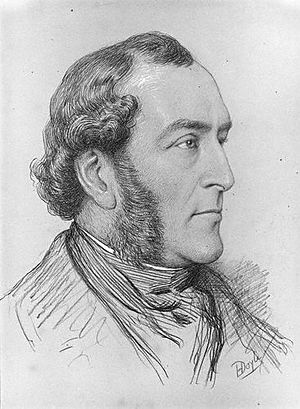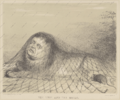John Doyle (Irish artist) facts for kids
Quick facts for kids
John Doyle (H. B.)
|
|
|---|---|

sketched in chalk by his son Henry Edward Doyle
|
|
| Born | 1797 |
| Died | 2 January 1868 (aged 70) |
| Nationality | Irish |
| Education | Royal Dublin Society |
| Known for | Political caricature, painting, lithography |
John Doyle (born in Dublin, Ireland, in 1797 – died in London, England, on January 2, 1868) was a very clever Irish artist. He was known by his secret pen name, H. B.. Doyle was famous for drawing funny pictures of politicians, called political cartoons or caricatures. He also painted and used a special printing method called lithography. His work helped shape the style of British cartoons for many years.
Contents
Early Life and Artistic Beginnings
John Doyle was born in Dublin, Ireland, in 1797. He was the oldest son of a silk merchant. His family had a long history, but they had lost their lands because of their religion. From a young age, John showed artistic talent.
Learning to Paint
He learned to paint landscapes from an artist named Gaspare Gabrielli. He also studied how to paint tiny portraits, called miniatures, at the Royal Dublin Society's drawing school. In 1805, he won a gold medal, which showed how skilled he was.
John Doyle painted pictures of horses and important people, like the Marquess of Sligo. In 1822, he created six prints about the life of a racehorse. That same year, he moved to London with his wife, Marianna Conan. His painting Turning out the Stag was shown at the Royal Academy in 1825, which brought him more attention.
The Secret Identity of H. B.
Sadly, Marianna died in 1832 while giving birth to their seventh child. John Doyle continued to paint miniatures for a few more years. However, he found even greater success with his political cartoons. These cartoons were printed using a new method called lithography, starting in 1827.
He released these cartoons once a month when the British Parliament was meeting. He continued doing this for 22 years! His drawings were usually very good likenesses of the people he drew, without too much exaggeration. He often used gentle humor and referred to popular plays of the time. He signed his cartoons with the letters H. B., which he cleverly made from his own initials, J. D.
By 1840, John Doyle was successful enough to live in a nice house in Hyde Park, London. He spent time with famous writers and artists like Charles Dickens and Walter Scott. But his true identity as H. B. was a secret until 1843, when he finally told Sir Robert Peel in a long letter.
Artistic Career and Influence
In the 1840s, H. B.'s cartoons were very popular. Newspapers like The Times even published lists of his prints. However, over time, his fame began to fade. His later cartoons had a softer humor and a less distinct drawing style.
A Gentle Humorist
A famous writer named William Makepeace Thackeray once said that Doyle's cartoons, while clever, were too "gentle" to make people laugh out loud. He said, "You will never hear any laughing at 'H. B.'"
When John Doyle died in 1868, his obituary (a notice about his death) didn't even appear in The Art Journal until three months later. Later, in 1882, a sale of his sketches was canceled because no one wanted to buy them.
Lasting Legacy
Even though his fame faded, John Doyle is considered a very important artist. He helped start a new style of British cartooning. His work influenced famous cartoonists like John Leech and John Tenniel, who worked for the well-known Punch magazine. His own son, Richard Doyle, also became a famous illustrator in this style. The British Museum in London has over 900 of John Doyle's drawings in its collection.
Death and Family Legacy
John Doyle passed away in London on January 2, 1868. He was buried at West Norwood Cemetery.
He had several talented sons who also became artists:
- James William Edmund Doyle (1822–1892) was an illustrator.
- Richard Doyle (1824–1883) was a painter, illustrator, and cartoonist.
- Henry Edward Doyle (1827–1892) became the director of the National Gallery of Ireland.
- Charles Altamont Doyle (1832–1893) was a painter.
Through his son Charles, John Doyle was the grandfather of Sir Arthur Conan Doyle. Arthur Conan Doyle became a world-famous novelist, best known for creating the detective Sherlock Holmes.
Gallery
-
A trip to Dover, showing the Duke of Wellington and his friends Sir Thomas Burdett, Lord Lyndhurst, and Lord Brougham in 1839.
-
The lion and the mouse, from 1844, showing Daniel O'Connell and John Russell, 1st Earl Russell. This artwork is in the Pushkin Museum.




